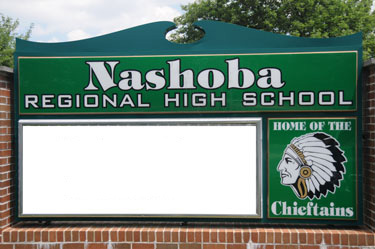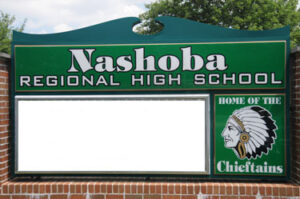
By Ann Needle
During its final meeting of the school year Tuesday night, the Nashoba School Committee finished some year-end housekeeping, completing policy decisions and holding discussions that will impact future policy.
After two postponements, the Committee worked through its promised discussion of community responses to the District Improvement Survey. The Survey was conducted this spring as part of Nashoba’s annual update of its District Improvement Plan. Nashoba staff and residents were invited to fill out the two-part survey on the district website. Topics focused on Nashoba’s communication efforts in several areas, along with respondents’ feelings on a wide range of possible changes in the district.
Much of the talk revolved around how a draft of Superintendent Michael Wood’s goals for next year dove-tail with survey results. To be completed by April 2014, Wood’s goals include establishing a district plan to address students at all ability levels that Wood termed “students who, for lack of a better term, are ‘checking out’ and need to be brought back in;” to put a plan in place for needed facility repairs that Nashoba towns could support, such as the high school Science labs; and implementing revamped teacher, administrator, and superintendent evaluation plans. Wood also mentioned a “personal/professional” goal of bringing NRHS from a level 2 to level 1 high school in the state.
Among remarks from the Committee, Stow Rep. Jeff Odell asserted that, looking at the last goal, Wood should have more of these “measurable goals.” Responding to Co-Chair Nancy Federspiel of Bolton’s remark that the many District Improvement Survey respondents appeared unhappy with the district’s communication efforts, Wood maintained, “We communicate tremendously well. The challenge is that we have seven schools, seven different websites, and the information is all dispersed among that. People just have to go to these.” Wood added, “I have been an advocate for one website for that reason.”
Wood committed to gathering statistics on surrounding school districts during the summer. “We may find that districts in the top 10% of SAT scores, say, spend about $3,000 more per pupil than we do,” Wood explained. “If that’s the case, then you, as a Committee, would need to grapple with [how to address] that.”
Based on the survey, the Policy Subcommittee also will revamp and re-submit the District Improvement Plan for a vote in September.
Next Step: Concessions
With first phase of the revamp to the high school’s athletic complex completed, including the new turf field, Nashoba is working on putting in a concession stand by late August. To help keep costs down, Director of Facilities Bill Cleary noted that he designed the layout for the area.
The stand will likely be a modular built for low maintenance, with features such as a metal roof, plastic siding, and cement base, according to Cleary. It will include a prep kitchen containing a refrigerator, freezer, sink, and warming oven. Cleary said that NRHS doesn’t have the staff to do proper training on more extensive equipment —for example, a fryer. However, Cleary said he would like the school to consider adding an accompanying “grilling pavilion” later on.
An important addition will be public restrooms. Right now, spectators and athletes must use the facilities inside the school, which is considered a safety hazard. The new bathrooms will be open to anyone renting the facilities (including for practices) whether or not they are associated with Nashoba, said Michael Wood.
Assistant Superintendent George King estimated the cost of the concession stand at $300,000. This would put the total project cost at about $2.36 million, about $150,000 beyond the $2.2 million bond approved by the district towns. The extra money could be made up by tapping other funds already approved for the 2013/14 budget, including the district’s cash school choice accounts, if any extra is available, he said. Wood maintained, “It has to be very clear: No additional monies are being asked of the towns.”
After several drafts, the Committee unanimously approved the School Resource Officer Policy and job description for the High School. When school re-opens in August, an appointed Bolton police officer will be placed part-time at the high school, in hopes that the officer will build a rapport with students, helping to head off any trouble. The District and Bolton Police will split the approximately $20,000 annual cost for the officer.